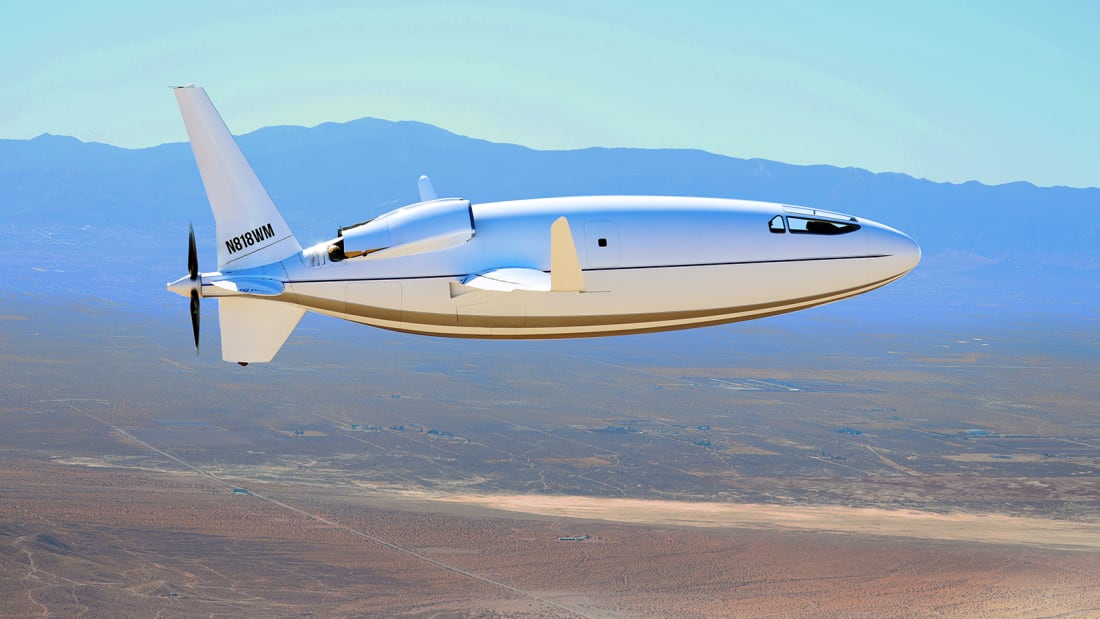Fascinating concept....one that I'm surprised hasn't arrived before.
Long-awaited Celera 500L 'bullet' plane is finally revealed
Excerpted....
Now, in the late summer of the strangest year in aviation history, the Celera 500L has finally been revealed to the world, with the launch of a new website and a bunch of very cool new photos.
What we're looking at is a six-person private craft that promises to fly at jet speeds, but with eight times lower fuel consumption, and a range that's twice that of a comparably sized craft.
Bold claims indeed. Otto Aviation says on its website that 31 successful test flights have so far been performed, with aerodynamic efficiency proven in 2019, bolstering its declaration that "the Celera 500L is the most fuel-efficient, commercially viable aircraft in existence."
The company, founded in 2008 and an offshoot of Bill Otto's Otto Laboratories, says that the Celera 500L runs at 18 to 25 miles-per-gallon fuel economy (compared to the 2-3 miles-per-gallon of a comparable jet aircraft).
Then there are the modest $328 hourly operating costs, which are about six times lower, and the generous 4,500-nautical-mile range. Maximum cruise speed is projected to reach more than 460 miles per hour.

"Our goal has always been to create a safe and private aircraft that would allow for direct flights in the US at speeds and cost comparable to commercial air travel," company CEO Bill Otto Jr. tells CNN Travel.
The range is such that the Celera 500L would be able to service nearly every city pairing in the United States without refueling.
The reason its aircraft can do all this, says Otto Aviation, is down to laminar flow.
Laminar flow is the minimum drag solution for aircraft surfaces, explains its website, and features smooth layers of airflow with little to no mixing of adjacent layers.
What the Celera 500L lacks in generous feature windows, it makes up for with a fuselage that takes advantage of an optimum length-to-width ratio to maximize laminar flow. Laminar shapes are also used for the wings and tail sections.
Inside, the cabin lacks natural light but is still spacious enough, with its 6 foot 2 (1.88 meters) height and six first-class equivalent seats with customizable configuration.
With its aerodynamic airframe meaning it requires a lot less horsepower to achieve takeoff and cruise speeds, the Celera 500L is powered by the RED A03 engine. It has a Liquid cooled V12, twin 6-cylinder bank and, says Otto Aviation, offers best-in-class efficiency. It's certified to operate on Jet A1 and biodiesel.
Long-awaited Celera 500L 'bullet' plane is finally revealed
Excerpted....
Now, in the late summer of the strangest year in aviation history, the Celera 500L has finally been revealed to the world, with the launch of a new website and a bunch of very cool new photos.
What we're looking at is a six-person private craft that promises to fly at jet speeds, but with eight times lower fuel consumption, and a range that's twice that of a comparably sized craft.
Bold claims indeed. Otto Aviation says on its website that 31 successful test flights have so far been performed, with aerodynamic efficiency proven in 2019, bolstering its declaration that "the Celera 500L is the most fuel-efficient, commercially viable aircraft in existence."
The company, founded in 2008 and an offshoot of Bill Otto's Otto Laboratories, says that the Celera 500L runs at 18 to 25 miles-per-gallon fuel economy (compared to the 2-3 miles-per-gallon of a comparable jet aircraft).
Then there are the modest $328 hourly operating costs, which are about six times lower, and the generous 4,500-nautical-mile range. Maximum cruise speed is projected to reach more than 460 miles per hour.

"Our goal has always been to create a safe and private aircraft that would allow for direct flights in the US at speeds and cost comparable to commercial air travel," company CEO Bill Otto Jr. tells CNN Travel.
The range is such that the Celera 500L would be able to service nearly every city pairing in the United States without refueling.
The reason its aircraft can do all this, says Otto Aviation, is down to laminar flow.
Laminar flow is the minimum drag solution for aircraft surfaces, explains its website, and features smooth layers of airflow with little to no mixing of adjacent layers.
What the Celera 500L lacks in generous feature windows, it makes up for with a fuselage that takes advantage of an optimum length-to-width ratio to maximize laminar flow. Laminar shapes are also used for the wings and tail sections.
Inside, the cabin lacks natural light but is still spacious enough, with its 6 foot 2 (1.88 meters) height and six first-class equivalent seats with customizable configuration.
With its aerodynamic airframe meaning it requires a lot less horsepower to achieve takeoff and cruise speeds, the Celera 500L is powered by the RED A03 engine. It has a Liquid cooled V12, twin 6-cylinder bank and, says Otto Aviation, offers best-in-class efficiency. It's certified to operate on Jet A1 and biodiesel.


